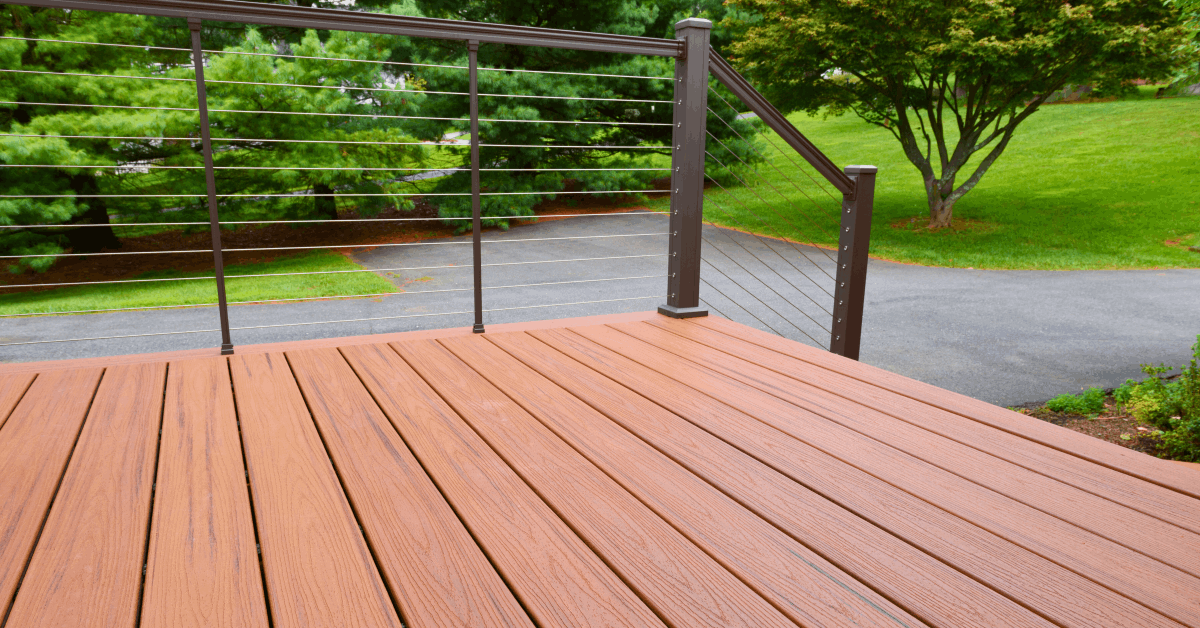
Decking takes a beating. It must endure sun, snow, storm, hail, heat, wind, rain, and ice. Day after day. Year after year. So while building a deck is an exciting home improvement project–offering family and friends a lovely space in which to enjoy the outdoors–because of the harsh environment it lives in, it’s important to choose the right material so it stays looking good.
But with the variety of decking materials available, choosing the right one can be overwhelming. The material you select not only impacts the deck’s appearance but also its durability and maintenance needs over time. Among the options available, composite decking has emerged as a top contender for homeowners looking for a blend of beauty and resilience. Here’s why.
What Is Composite Decking?
How Composite Decking Is Made
Composite decking is a man-made building product. So-called “engineered building products” are ubiquitous in construction these days, for both interior and exterior use. Composite decking boards include an equal mix of recycled wood fibers and recycled plastic that are bonded together. These materials combine to create a composite board that mimics the look of wood but comes with enhanced durability and a reduced need for maintenance. Composite decking boards are often capped with a polymer shell for even greater resistance to the elements.
Comparison With Traditional Wood Decking
Wood is wood, and while beautiful, when used for decking it can warp and splinter. It also requires regular upkeep, including staining, sealing, and the occasional replacement of damaged boards. Composite decking is engineered to resist these common issues. The beauty of composite decking is that it provides the aesthetic appeal of wood without the hassle–able to maintain its appearance and structure for years with minimal effort or expense on your part.
Benefits of Composite Decking Boards
Durability: Resistant to Rot, Mold, and Insects
Wood will rot. Maybe not the wood inside your house, but with enough exposure to the elements all exterior woods–even those that are pressure treated–will eventually break down. As such, one of the most significant advantages of composite decking boards is their durability: their stubborn resistance to the common issues that plague wood decks, such as rot, mold, and even insect infestations. This means your deck will maintain its structural integrity and appearance.
Low Maintenance: No Need for Staining, Sealing, or Painting
Wood requires upkeep. Painting. Staining. Sealing. Composite decking is very low-maintenance by comparison, as there’s no need for any of the aforementioned tasks. A simple occasional cleaning is all that’s required to keep your composite board deck looking great. This ease of maintenance allows you to spend more time enjoying your deck versus working on it.
Aesthetics: Wide Variety of Colors and Textures that Mimic Wood
There was a time when composite decking boards came in a limited range of colors. No longer. With their increasing popularity and advancements in manufacturing technology, there’s now a wide range of composite decking colors available for homeowners to choose from. Textures have come a long way, as well, with finishes that make composite decking essentially indistinguishable from natural wood–whether you prefer the look of oak, cedar, or walnut, These boards also maintain their color and finish over time, without fading, unlike traditional wood.
Eco-Friendly: Made From Recycled Materials
For environmentally-conscious homeowners, composite boards also make a great decking choice. The wood fibers and plastics they’re made from are recycled materials, which means less waste going into landfills and fewer trees being cut down. Thus, a composite deck installation supports sustainability efforts–reducing your environmental footprint.
Long-Term Cost Efficiency: Lower Maintenance and Replacement Costs Over Time
Composite boards can be more expensive to buy upfront, it’s true, but they’re cheaper in the long run. The reduced need for maintenance, combined with greater durability, means composite decking requires fewer repairs and replacements over the lifespan of your deck.
Common Misconceptions About Composite Decking
Myths: “Composite Decking Looks Fake” And “It’s Too Expensive”
Despite its demonstrated benefits, myths about composite decking persist. One common myth is that composite decking looks fake, or that it looks like plastic. Again, this is no longer the case. Advancements in materials technology and manufacturing mean modern composite decking is almost indistinguishable from natural wood. Another persistent myth is that composite decking is prohibitively expensive. Again, while the upfront cost may be higher, the savings on maintenance and replacement boards more than make up for it over the lifespan of the deck.
Advancements in Technology That Make Composite Decking a Viable Option
Technology marches on, and not just in the obvious industries, like electronics. The construction industry benefits from technological advancement, too. Innovations in materials manufacturing have enhanced the durability, texture, and eco-friendliness of composite decking boards, not to mention the expansive range of composite decking colors now available. All of this makes a composite deck installation a superior option for those who want a long-lasting, beautiful deck.
Strong, Stylish, Smart
Outdoor spaces are an important part of any home. As much as having a home is about a place to stay warm and dry in comfort and style, being able to get out into the fresh air and entertain or just relax is arguably just as important. So if you’re building a deck you want it to last, and you want it to look good for a long time. Composite decking offers a compelling combination of durability, low maintenance, aesthetic appeal, and environmental benefits. It stands out as a smart investment for any homeowner looking for a long-lasting and beautiful outdoor space.

